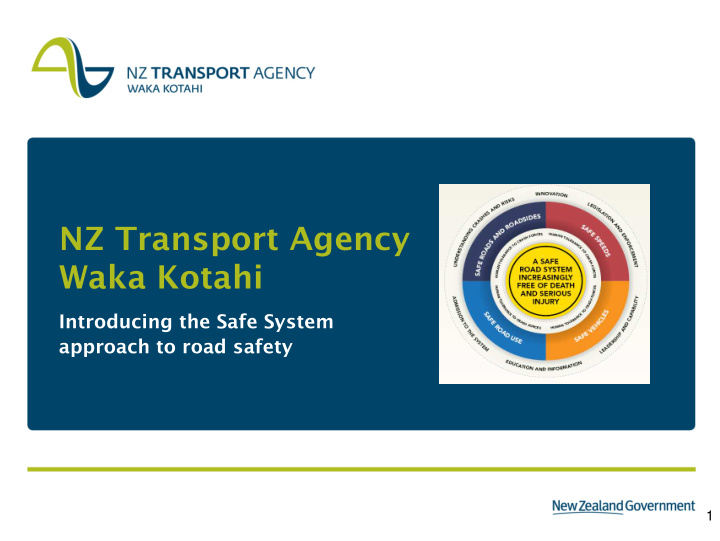



NZ Transport Agency Waka Kotahi Introducing the Safe System approach to road safety 1
Purpose for today To provide an overview of the Safe System approach to road safety and discuss the way we think about and manage road safety. 2
The Safer Journeys Safe System Vision Safer Journeys, New Zealand’s Road Safety Strategy 2010-2020, envisions: “A safe road system increasingly free of death and serious injury” 3
Why we need a different approach Our current road transport system is not as safe as it could be: Scandinavian research indicates that even if all road users complied with road rules, fatalities would only fall by around 50% and injuries by 30%. If everybody obeyed the road rules, New Zealand would still have around 200 road deaths each year. 4
The Safe System approach The Safe System approach is about acknowledging: 1. human beings make mistakes and crashes are inevitable 2. the human body has a limited ability to withstand crash forces 3. system designers and system users must all share responsibility for managing crash forces to a level that does not result in death or serious injury 4. it will take a whole-of-system approach to implement the Safe System in New Zealand. 5
Human fallibility 1. human beings make mistakes and crashes are inevitable 6
Human vulnerability 2. the human body has a limited ability to withstand crash forces 7
Shared responsibility Who is a system designer? System designers include planners, engineers, policy 3. system designers and makers, educators, system users must all enforcement officers, vehicle importers, share responsibility suppliers, utility providers, for managing crash insurers etc. forces to a level that Who is a system (road) does not result in user? death or serious injury System users include drivers, vehicle passengers, motorcyclists, cyclists, pedestrians etc. 8
Where responsibility sits Traditional focus: Safe System focus: � Target driver behaviour � Improve the system 9
Whole of system 4. it will take a whole-of-system approach to implement the Safe System in New Zealand. 10
The Safe System: an example Why did that silly bugger crash into the pole? New approach: What silly bugger put the pole where it could be crashed into? 11
Key components of the Safe System approach to road safety The Safe System approach for system designers 12
The Safer Journeys Safe System diagram 13
Safe road design Safe roads and roadsides – that are predictable and forgiving of mistakes. Their design should encourage appropriate road user behaviour and safe speeds Centre barriers and medians on rural roads Roundabout treatments at intersections Removal/barrier protection of roadside hazards Greater use of rumble strips 14
Safe speed design Safe speeds – that should suit the function and level of safety of the road. Road users understand and comply with speed limits and drive to the conditions Rural road speed limits based on level of road protection More 80km/h speed zones where 100km/h open road limit is not safe Encouraging <40km/h in urban zones Speed messaging and ISA 15
Safe vehicle design Safe vehicles – that help prevent crashes and protect road users from crash forces that cause death and serious injury Promoting advanced vehicle safety features to consumers Electronic Stability Control and head protecting airbags Intelligent Speed Adaption (ISA) 16
Safe road use design Safe road use – ensuring road users are skilled and competent, alert and unimpaired. That people comply with road rules, choose safer vehicles, take steps to improve safety, and demand safety improvements Encouraging a culture of driving to the conditions Improving driver skills Improving licensing systems 17
Whole-of-system connections The Safe System is greater than the sum of its parts. Even slight improvements across roads, speeds, vehicles and users will lead to proportionally greater safety outcomes. 18
How do we get there? 19
What happens next? The Safe System approach to be incorporated into RSAPing Road safety reporting Crash data gathering and analysis Demonstration projects Road safety audits More information: For further info see www.nzta.govt.nz 20
Thank you 21
Recommend
More recommend